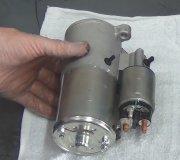Hi College Kid. Welcome to the forum. We can find this with a series of voltage measurements with a cheap digital voltmeter. First of all, do not pull off a battery cable when the engine is running. It dampens voltage spikes and is needed to smooth out the ripple that comes from the generator. That ripple will be amplified by the generator itself, and system voltage can easily reach 30 volts or more if you rev the engine. On newer cars with lots of unreliable computers, you can instantly do many thousands of dollars worth of damage. Removing the cable was a simple trick done years ago by mechanics who didn't understand basic electrical theory. Also, some generators will stop working when the battery is disconnected so the test will point in the wrong direction. There's a much easier way to tell if the generator is working.
Since a recharged battery still leads to a no-crank condition, use a digital voltmeter to measure battery voltage between the two posts. It must be near 12.6 volts. Turn on the headlights. If they are dim, move one of the meter probes at a time from the battery post to its cable connector, then to the next place the cable attaches to. You're looking for the place where voltage is considerably lower that at the battery. That connection must be cleaned and tightened, or the cable must be replaced. Think of measuring pressure in a water pipe. The point where pressure drops is where the blockage is located, but that pressure drop will only occur if water is flowing. The voltage drop in the circuit will only occur if current is trying to flow, hence the head lights.
If the head lights are bright, do the same voltage tests while a helper tries to crank the engine. If you find at least 12 volts all the way to the starter, suspect worn solenoid contacts inside it. They can be replaced for 20 bucks, but most people just replace the entire starter. A jumper pack will often overcome the poor contact for a while. The clue is everything else on the car works normally such as the radio and dome lights, etc.
To tell if the charging system is working, use your voltmeter to measure battery voltage while the engine is running. It must be between 13.75 and 14.75 volts.
Caradiodoc
SPONSORED LINKS
Thursday, February 25th, 2021 AT 4:17 PM




